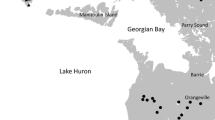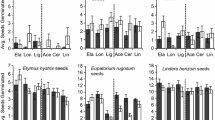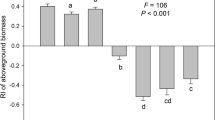Abstract
Carduus nutans L. is an invasive pasture/grassland species which may undergo rapid population growth through positive feedback. Plants ofC. nutans produce a vegetative rosette, and after several months produce stems containing flower-heads, during which time the rosette leaves die and decompose. We investigated the influence ofC. nutans on the nitrogen-fixation ability ofTrifolium repens L. in three experiments. The first experiment was set up in a “mixture” design, and demonstrated that seedlings ofT. repens were more susceptible to competition with otherT. repens seedlings than toC. nutans seedlings. Nodule numbers and acetylene reduction per unit root, and acetylene reduction per unit nodules were adversely affected by increasingT. repens, but notC. nutans densities. The second experiment was of an additive design, with separate partitions to isolate above-ground and below-ground interference. FloweringC. nutans plants strongly inhibitedT. repens root growth, nodulation and acetylene reduction, but usually only when shoot interference was permitted. This appears to be due to decomposition of rosette leaves, which was maximal at this stage. The third experiment involved monitoring effects of taggedC. nutans individuals againstT. repens in the field. This experiment showed that acetylene reduction was severely influenced by floweringC. nutans (when rosette leaves were decomposing), even when only mild reduction ofT. repens growth was observed, and these effects persisted for some months after theC. nutans plants had died. The results of these experiments in combination suggest that decomposing rosette leaves have a strong potential to inhibitT. repens nitrogen fixation. It appears that allelopathy is involved, since alternative explanations (e.g. root competition byC. nutans; effects ofC. nutans on soil moisture, microbial nutrient immobilisation and light availability; facilitation of herbivores byC. nutans) can be effectively discounted. Although invasive species are often assumed to be associated with soil nitrogen build-up, we believe that some invasive species such asC. nutans have the potential to induce long-term decline of soil nitrogen input.
Similar content being viewed by others
References
Anderson J P E and Domsch K H 1978 A physiological method for the quantitative measurement of microbial biomass in soils. Soil Biol. Biochem. 10, 215–221.
Bartholomew B 1970 Bare zones between California shrub and grassland communities: the role of animals. Science 170, 1210–1212.
Blum U and Rice E L 1969 Inhibition of symbiotic nitrogen-fixation by gallic and tannic acid, and possible roles in old-field succession. Bull. Torrey Botanical Club 96, 531–544.
Clements F E 1936 Nature and structure of the climax. J. Ecol. 24, 252–284.
Connolly J 1988 What is wrong with replacement series? Trends Ecol. Evol. 3, 24–26.
Doing H, Biddiscombe E F and Knedlhans S 1969. Ecology and distribution of theCarduus nutans group (nodding thistle) in Australia. Vegetatio 17, 313–351.
Donald C M 1958 The interaction of competition for light and for nutrients. Aust. J. Agric. Res. 9, 421–435.
Dunlop J and Hart A L 1987 Mineral nutrition.In White clover. Eds. M J Barker and W M Williams. pp. 153–183. CAB International, Wallingford.
Finegan B 1984 Forest succession. Nature 312, 109–114.
Firbank L G and Watkinson A R 1985 On the analysis of competition within two-species mixtures of plants. J. Appl. Ecol. 22, 503–517.
Gaudet C L and Keddy P 1988 A comparative approach to predicting competitive ability from plant traits. Nature 334, 242–243.
Grime J P 1973 Competitive exclusion in herbaceous vegetation. Nature 242, 344–347.
Groves R H and Williams J D 1975 Growth of skeleton weed (Chondrilla juncaea L.) as affected by growth of subterranean clover (Trifolium repens L.) and infection byPuccinia chondrillina Bubak & Syd. Aust. J. Agric. Res. 26, 975–983.
Harper J L 1977 Population Biology of Plants. Academic Press, London. 892 p.
Hobbie S E 1992. Effects of plant species on nutrient cycling. Trends Ecol. Evol. 7, 336–339.
Hoglund J H and Brock J L 1978 Regulation of nitrogen fixation in a grazed pasture. N.Z. J. Agric. Res. 21, 73–82.
Law R and Watkinson A R 1987 Response-surface analysis of two-species competition: an experiment onPhleum arenarium andVulpia fasciculata. J. Ecol. 75, 871–886.
Miles J 1985 The pedogenic effects of different species and vegetation types and the implications of succession. J. Soil Sci. 36, 571–584.
Minchin F R, Sheehy J E and Witty J F 1986 Further errors in the acetylene reduction assay: effects of plant disturbance. J. Exp. Bot. 37, 1581–1591.
Minchin F R, Witty J F and Mytton L R 1994 Reply to “measurement of nitrogenase activity in legume root nodules: in defence of the acetylene reduction assay” by J K Vessey. Plant and Soil 158, 163–167.
Minchin F R, Witty J F, Sheehy J E and Müller M 1983 A major error in the acetylene reduction assay: decreases in nodular activity under assay conditions. J. Exp. Bot. 34, 641–649.
Murthy M S and Nagodra T 1977 Allelopathic effects ofAristida adscensionis onRhizobia. J. Appl. Ecol. 14, 279–282.
Murthy M S and Ravindra R 1974 Inhibition of nodulation ofIndigofera cordifolia byAristida adscensionis. Oecologia 16, 257–258.
Norberg R Å 1988 Theory of growth geometry of plants and self-thinning of plant populations: geographic similarity, elastic similarity, and different growth modes of plant parts. Am. Nat. 131, 220–256.
Okano S, Kondo H and Sawada Y 1989 Soil microbial biomass in a sasa-type (Pleio blastus) grassland. Japanese J. Grassl. Sci. 34, 280–285.
Okano S, Sato K and Inove K 1991 Negative relationship between microbial biomass and root amount in topsoil of a renovated grassland. Soil Sci. Plant Nutr. 37, 47–53.
Panetta F D and Wardle D A 1992 Gap size and regeneration in a New Zealand dairy pasture. Aust. J. Ecol. 17, 169–175.
Pickett S T A, Collins S L and Armesto J J 1987 Models, mechanisms and pathogens of plant succession. Bot. Rev. 53, 335–371.
Popay A I and Medd R W 1990 The biology of Australian weeds. 21.Carduus nutans L. ssp.nutans. Plant Prot. Quart. 5, 3–13.
Rice E L 1964 Inhibition of nitrogen-fixing and nitrifying bacteria by seed plants. Ecology 45, 824–837.
Rice E L 1965 Inhibition of nitrogen-fixing and nitrifying bacteria by seed plants. III. Comparison of three species ofEuphorbia. Proc. Oklahoma Acad. Sci. 45, 43–44.
Rice E L 1992 Allelopathic effects on nitrogen cycling.In Allelopathy — Basic and Applied Aspects. Eds. S J H Rizvi and V Rizvi. pp. 31–58. Chapman and Hall, London.
Roberts D W 1987 A dynamical perspective on vegetation ecology. Vegetatio 69, 27–33.
Sarma K K V 1983 Allelopathic potential of the phytoextracts ofAristida ascendionis Linn. Trop. Ecol. 24, 19–21.
Smith G S, Johnson C M and Cornforth I S 1983 Comparisons for nutrient solutions for plants in sand culture. New Phytol. 94, 537–548.
Snaydon R W 1991 Replacement or additive designs for competition studies? J. Appl. Ecol. 28, 930–946.
Tough H J and Crush J R 1979 Effect of grade of acetylene on ethylene production by white clover (Trifolium repens L.) during acetylene reduction assays of nitrogen fixation. N.Z. J. Agric. Res. 22, 581–583.
Vessey J K 1994 Measurement of nitrogenase activity in legume root nodules: in defense of the acetylene reduction assay. Plant and Soil 158, 151–162.
Vitousek P M and Walker L R 1989 Biological invasion byMyrica faya in Hawaii: plant demography, nitrogen fixation, ecosystem effects. Ecol. Monogr. 59, 247–265.
Wardle D A 1992 A comparative assessment of factors which influence microbial biomass carbon and nitrogen levels in soils. Biol. Rev. 67, 321–358.
Wardle D A and Parkinson D 1990 Comparison of physiological techniques for estimating the response of the soil microbial biomass to soil moisture. Soil Biol. Biochem. 22, 817–873.
Wardle D A, Nicholson K S and Rahman A 1992 Influence of pasture grass and legume swards on seedling emergence and growth ofCarduus nutans L. andCirsium vulgare L. Weed Res. 32, 119–128.
Wardle D A, Nicholson K S and Rahman A 1993a Influence of plant age on the allelopathic potential of nodding thistle (Carduus nutans L.) against pasture grasses and legumes. Weed Res. 33, 69–78.
Wardle D A, Nicholson K S and Rahman A 1993b Aspects of interactions between nodding thistle (Carduus nutans L.) and pasture grasses and legumes. Proc. Internat. Grassl. Congr. 17, 355–356.
Wardle D A, Yeates G W, Watson R S and Nicholson K S 1993c Response of soil microbial biomass and plant litter decomposition to weed management strategies in maize and asparagus ecosystems. Soil Biol. Biochem. 25, 857–868.
Wardle D A, Nicholson K S, Ahmed M and Rahman A 1994 Influence of pasture forage species on seedling emergence, and growth and development ofCarduus nutans L. J. Appl. Ecol. (In press).
West A W and Sparling G P 1986 Modifications to the substrate induced respiration method to permit measurement of microbial biomass in soils of differing water content. J. Microbiol. Meth. 5, 177–189.
Weston L A and Putnam A R 1985 Inhibition of growth, nodulation and nitrogen fixation of legumes by quackgrass (Agropyron repens). Crop Sci. 25, 561–565.
Williamson G B 1990 Allelopathy, Koch's postulates and the neck riddle.In Perspectives on Plant Competition. Eds. J BGrace and DTilman. pp. 142–162. Academic Press, San Diego.
Wilson J B 1988 Shoot competition and root competition. J. Appl. Ecol. 25, 279–296.
Wilson J B and Agnew A D Q 1992. Positive-feedback switches in plant communities. Adv. Ecol. Res. 23, 263–336.
Author information
Authors and Affiliations
Rights and permissions
About this article
Cite this article
Wardle, D.A., Nicholson, K.S., Ahmed, M. et al. Interference effects of the invasive plantCarduus nutans L. against the nitrogen fixation ability ofTrifolium repens L.. Plant Soil 163, 287–297 (1994). https://doi.org/10.1007/BF00007978
Received:
Accepted:
Issue Date:
DOI: https://doi.org/10.1007/BF00007978




